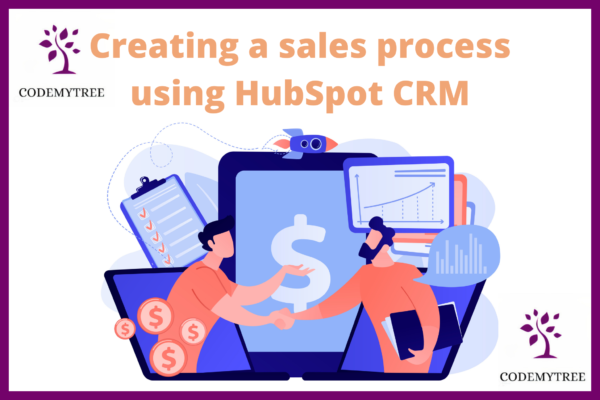
You might have heard about ‘Sales Process’ but what exactly is it?
Sales process is the procedure of convincing customers to buy your product or services. It involves a series of steps which usually begins with identifying the potential leads with whom you further build a relation and close the deal. A well defined sales process helps to increase lead generation as well as close more sales. If each step of the process is performed correctly then the sales process has a good chance of being successful. It is crucial to select the right CRM while preparing a sales process. In this blog, I will be talking about how you can use the HubSpot CRM to design a sales process.
But before that
What Are The Steps Involved In Setting Up A Sales Process?
The typical sales workflow goes as follows
- Identifying and targeting the potential leads
- Building a relation with them
- Qualifying leads
- Demoing the product or service to the leads
- Closing the deal
- Follow up on the product purchased
- Estimating the success rate.
HubSpot CRM: The Right Tool.
There are a lot of steps involved, so it is necessary to choose a CRM which can help you to create and manage these steps with ease. HubSpot CRM is a powerful software which allows you to streamline your sales processes and increase sales productivity.
HubSpot CRM allows you to track your leads through every stage of the sales cycle.
Designing Sales Process Using HubSpot CRM
In HubSpot, there is a section named ‘deals’ under which you can keep track of the buyer’s journey. They are organised in columns to represent different stages of the sales process. You can drag and drop the individual deals as your sales process. In order to make a well defined sales process it requires the understanding of the buyer’s journey which begins from searching for a specific product and later on evaluating it before closing the deal. It is the duty of the salesperson to navigate the buyer through the sales cycle.
Let us look at the steps in depth to understand the importance of them in the sales process
Step 1: Identifying And Meeting The Potential Customers
It is essential to attract the leads who are looking for solutions which could be solved by your company through the product or services you offer them. This is possible if you are advertising the product in the right way to reach the right audience at the right time through reliable sources. Once you identify potential leads, you connect with them through chatbots. Emails, newsletter etc and later on fix an appointment to understand their problem more clearly and provide them with solutions that are given by your company.
Step 2: Demoing The Product Or Service
Here, you are showing them how they can use your product as a solution to their problem. It must be convincing enough as they will be evaluating the product for their use as well. It is crucial to tell everything about the product to further avoid miscommunication and dissatisfaction which might come along the way later on.
Step 3: Follow Up
Once the potential client aware of every feature it is necessary to follow up on the lead if they are interested to buy the product by putting up deal and offers.
Step 4: Closing The Deal
Once the buyer approves of the product at a negotiated price, then it is time to close the sales by signing the contract which involves all the terms and conditions which are properly elaborated to the buyer.
Creation Of Deal Stages.
These are the essential steps involved in the sales processes. In order to eliminate the guesswork of estimating the deal closure, there are three characteristics to figure out the deal stages from sales process
- Factual– this is an action taken to kick start the journey of sales
- Inspectable– it is a proof that the action was taken to begin the sales process
- Buyer centric– closing of sales by the buyer.
If all these characteristics are present at the time of deal stages then it is safe to say that it is a good sales . In deal stage, It would look somewhat like this:
Evaluate product —> product evaluated
Decision maker evaluates —> evaluated by decision maker
sign/return contract —> contract is signed/returned
After translation, are the final two additional stages whose name could be customised but function remain the same
On radar– this is where you put the deals when you first create them. When a prospect responds to your product adverts and schedules an appointment then they are put up in this section. This is placed before the first stage
Closed lost– many at times even after advertising the product the right way, the prospect might not be that interested and not close the deal so they are put in the closed lost stage which is the final deal stage.
Final words.
The entire deal stage is now created with only 5 stages
On Radar—> Product Evaluated—> Evaluated by Decision Maker—> Contract Signed and Returned—> Closed Lost.
Thus creating a solid pipeline